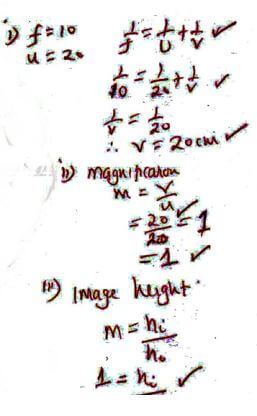Instructions to candidates
- This paper consists of two sections A and B
- Answer all the questions in the two sections in the spaces provided after each question
- All working must be clearly shown
- Electronic calculators, mathematical tables may be used
- All numerical answers should be expressed in the decimal notations
|
SECTION |
QUESTION |
MAX MARKS |
CANDIDATE’S SCORE |
|
A |
1 – 12 |
25 |
|
|
B |
13 |
13 |
|
|
14 |
07 |
|
|
|
15 |
11 |
|
|
|
16 |
13 |
|
|
|
17 |
11 |
|
|
|
TOTAL |
80 |
|
|

QUESTIONS
- On the diagrams below, show how a convex mirror gives a wider field of view than a plane mirror (2 marks)

- Figure 1 below shows a negatively charged object suspended using a thread A glass rod was rubbed using a wooden cloth and then brought closer to the object
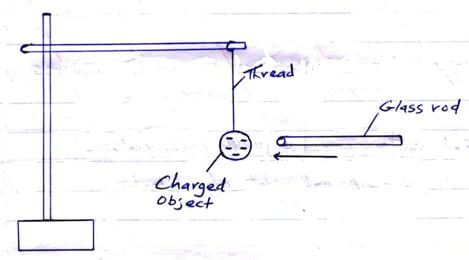
State the observation made when a rubbed glass rod is brought closer to the object (1 mark) - Figure 6 below shows a simple cell
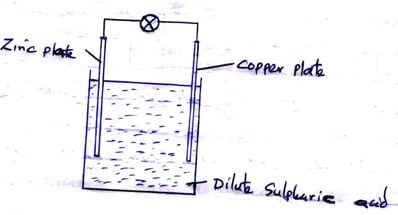
- On the same diagram, indicate the direction of current (1 mark)
- It is observed that the bulb goes off after a short time Explain this observation (1 mark)
- A coil of insulated wire is wound around a U-shaped soft iron core XY and connected to a battery as shown in the figure 3 below
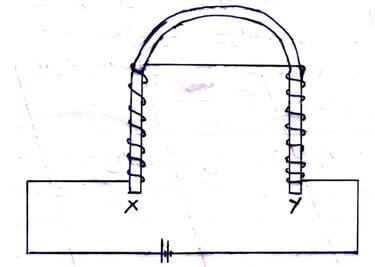
- On the same diagram, indicate the direction of current in the coil (1 mark)
- State the polarity of end X (1 mark)
- A soldier standing between 2 cliffs fires a gun He hears the first echo after 216s and the next after 475s Determine the distance between the two cliffs (Take speed of sound as 30m/s) (3 marks)
-
- Arrange the following waves in order of decreasing wavelength; x-rays, infrared, microwaves and visible light (1 mark)
- State one application of visible light (1 mark)
- An electric bulb is rated 40W, 240v, what is the resistance of the filament (2 marks)
- The figure 4 below shows a current carrying conductor placed perpendicularly between the poles of a magnet

- Show on the diagram; the magnetic field pattern (1 mark)
- The direction of net force on the conductor (1 mark)
- Study the circuit shown below
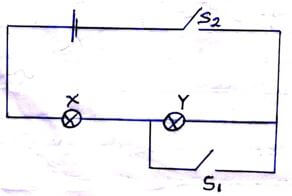
State and explain what happens to the identical lamps X and Y in the circuit, when:- Switch S2 only is closed (2 marks)
- Switches S1 and S2 are closed (2 marks)
- Figure 5 below shows sound waves emitted by a drum struck by a stone The sound waves are transmitted through air
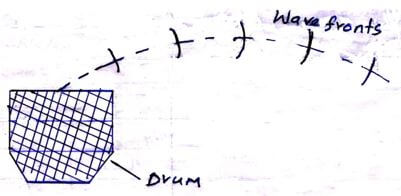
Explain why the wave fronts are directed towards the ground (2 marks) - State one advantage of using optical fibre in communication (1 mark)
- A cell supplies a current of 06A through two 2Ω resistors connected in parallel When the resistors are connected in series, the current is 18A Calculate the internal resistance of the cell (2 marks)
SECTION B (55 MARKS)
-
- Figure 7 below shows a series of wave fronts one wavelength apart approaching a gap between two barriers in a ripple tank
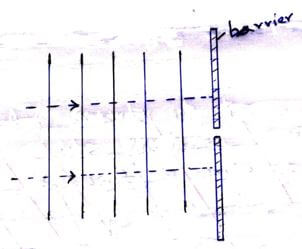
Show on the figure what happens as the waves pass the gap (1 mark) - A student set up a mass attached to a spring such that when it oscillates, it taps on the water surface in a wide shallow tank
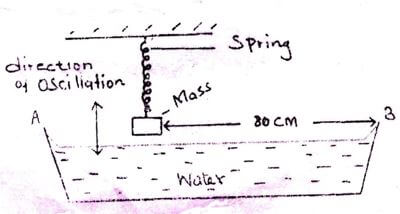
The student measured time for 20 oscillations and found that the mass takes 36seconds Given that the student counted four ripples between the mass and end B of the tank;- Determine,
- The frequency of the water waves (2 marks)
- The speed of the waves (3 marks)
- What would happen to the waves produced if the water is made shallower? (1 mark)
- Determine,
- In the experiment to observe interference of light waves, a double slit is placed close to the source as shown in figure 8 below
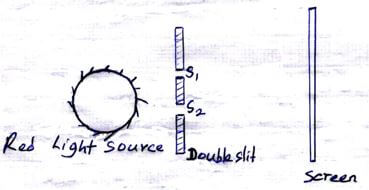
- State the function of the double slit (1 mark)
- State and explain what is observed on the screen (3 marks)
- State what is observed on the screen when:
- The slit separation S1S2 is reduced (1 mark)
- Violet light source is used in place of red light source (1 mark)
- Figure 7 below shows a series of wave fronts one wavelength apart approaching a gap between two barriers in a ripple tank
-
- State the conditions to be satisfied for total internal reflection to occur (2 marks)
- A ray of light traveling in the direction EO in air enters a rectangular block as shown in the diagram The resulting angle of refraction is 180
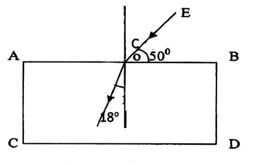
Find:- The refraction index of the block (2 marks)
- The critical angle c of the block (3 marks)
-
- State Ohm’s law (1 mark)
- A starter coil has a current of 6A passing through it If the pd across it is 12V, determine the resistance of the starter coil (3 marks)
- The graph below shows the voltage – current relationship for a conductor
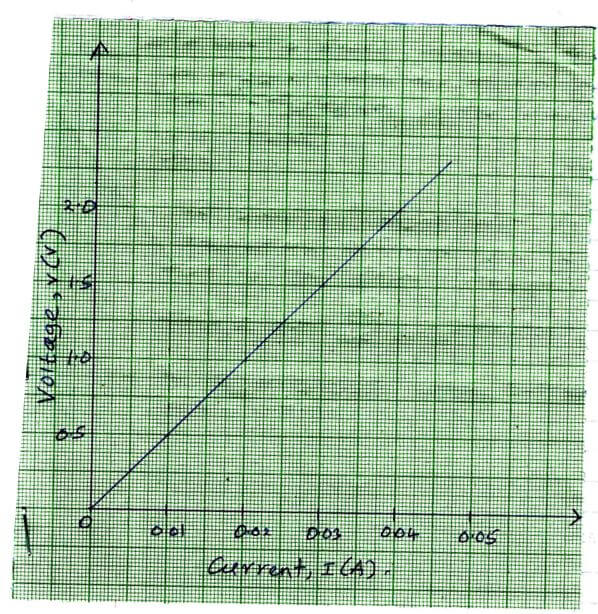
- Determine the resistance of the conductor (3 marks)
- State with reasons whether the conductor obeys Ohm’s law (2 marks)
- State two factors that determine the resistance of a conductor (2 marks)
-
- The figure below shows an object in front of a lens
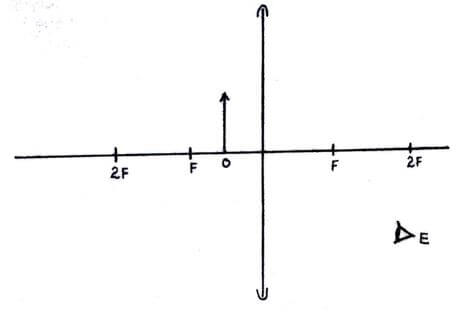
- Using rays, locate the image as seen by observer E (2 marks)
- Give one application of such lens as used above (1 mark)
- Figure I and II show diagrams of the human eye
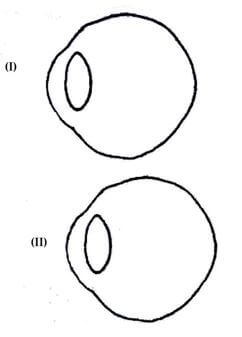
- In figure (I), sketch a ray diagram showing long sightedness (1 mark)
- In figure (II), sketch a ray diagram showing how lens is used to correct long sightedness (2 marks)
- An object of height 105cm stands before a converging lens of focal length 10cm and a distance of 20cm from the lens Determine;
- Image distance (3 marks)
- Magnification (2 marks)
- Height of the image (2 marks)
- The figure below shows an object in front of a lens
-
- Define capacitance of a capacitor (1 mark)
- State two factors affecting capacitance of parallel plate capacitor (2 marks)
- The diagram shows 3 capacitors 4μF, 5μF and 6μF connected to a 12V dc supply
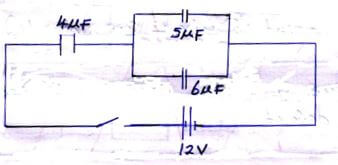
Determine;- The effective capacitance (3 marks)
- The charge stored in the 4μF capacitor (2 marks)
- The pd across 5μF capacitor (3 marks)

MARKING SCHEME
-
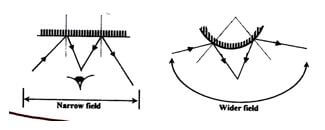
- They attract. √1
-
-
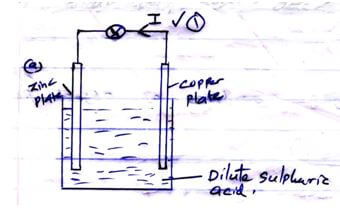
- The cell suffers polarization and local action.√1
-
-
-

- North pole√1
-
- V = 2d/t √
330 = 2xd/2.16
d = (330 x 2.16)/2
d = 356.4m
330 = 2xd/4.75
d = 330x4.75/2 √
= 783.75m
Distance between the wall = 356.4 + 783.75
= 1140.15m √ -
- Microwaves, infrared, visible light, X-rays.
- Observing objects
Taking pictures.
- P = v2/R
40 = (240)2/R
R = 57600/40
= 1440Ω 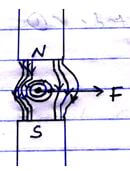
Field – 1 mark (N – S; around conductor)
Force – 1 mark-
- Bulbs X and Y light dimly. √1
They are connected in series and resistance add up.
Or Bulbs X and Y light with same brightness. The same current flows through them.√1 - Bulb X lights brightly while Y does not.
Bulb Y is short circuited. √1
- Bulbs X and Y light dimly. √1
- Air is warmer at upper layer. √1
Velocity of sound wave fronts will be higher in the upper layer than in the lower layer hence the waves will be refracted downward. - More information can be transmitted at the same time.√1
Flexible. - Circuit 1
E = V + Ir
E = 0.6 + 0.6r (1) √
E = 7.2 + 1.8r (2)
Equation 1 & 2
1.2r = 6.6
r = 5.8Ω √ -
-
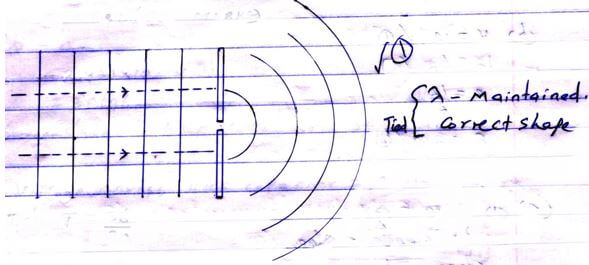
-
-
- T = 36/20
ƒ = 1/T
ƒ = 20/36 √1
= 0.5556Hz √ - v = ƒλ √
= 0.5556 x 0.80/4√1
= 0.1111m/s √1
- T = 36/20
- Waves of shorter wavelength are produced /more waves are produced (shorter wavelength).
-
-
- It provides coherent sources.√1
- Alternating dark and bright fringes.√1
Dark fringes are due to destructive interference√1 while bright fringes are due to constructive √1 interference -
- Increased distance between the fringes. √1
- Fringes will be closer.√1
-
-
-
- Light must travel from optically denser medium to less dense medium.
- Angle of incidence in the denser medium must be greater than critical angle.
-
- sini/sinr = n
n = sin40/sin18º
n = 2.080 - sin C = 1/n Allow T.E (Transfer of Error)
sin C = 1/2.08
C = sin-1 0.48077
C = 28.74º
- sini/sinr = n
-
-
- The current flowing through a current carrying conductor is directly proportional to the potential difference across it provided temperature and other physical conditions are kept constant. √1
- v = IR √1
12 = 6R √1
R = 12/6
R = 2Ω √1 -
- Slope = (Δ v)/(Δ I)
Resistance = slope √1
Slope = (1-0.5)/(0.02-0.01) √1
= 0.5/0.01
= 50Ω
Resistance = 50Ω √1 - It obeys Ohm’s law √1
Current is directly proportional to voltage √1
- Slope = (Δ v)/(Δ I)
- Cross-section area /thickness of √1 the conductor.
Length of the conductor √1
Temperature (Any 2 correct)
-
-
-
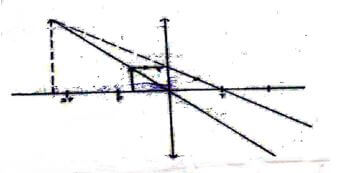
- As a magnifying glass
-
-
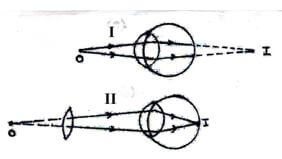
-
-
-
-
- Charge per unit voltage √1
- Area of overlap √1
Distance of separation √1
Type/Nature of dielectric (Any 2 correct) -
- CP = 5 + 6
= 11μF √1
Cλ = (11 x 4)/15 √1
Cλ = 2.933μϝ √1 - Q = Cv
= 2.933 x 12 √1
= 35.196μc √1
Charge stored in 4μϝ capacitor = 35.196μc - Voltage across 4μϝ capacitor = 35.196/4
= 8.799 √1
p.d across 5μϝ capacitor = 12 – 8.799 √1
= 3.201 √1
- CP = 5 + 6
- In rectification to smoothen output
Download Physics Paper 2 Questions and Answers - Arise and Shine Pre Mock Exams 2023.
Tap Here to Download for 50/-
Get on WhatsApp for 50/-
Why download?
- ✔ To read offline at any time.
- ✔ To Print at your convenience
- ✔ Share Easily with Friends / Students

